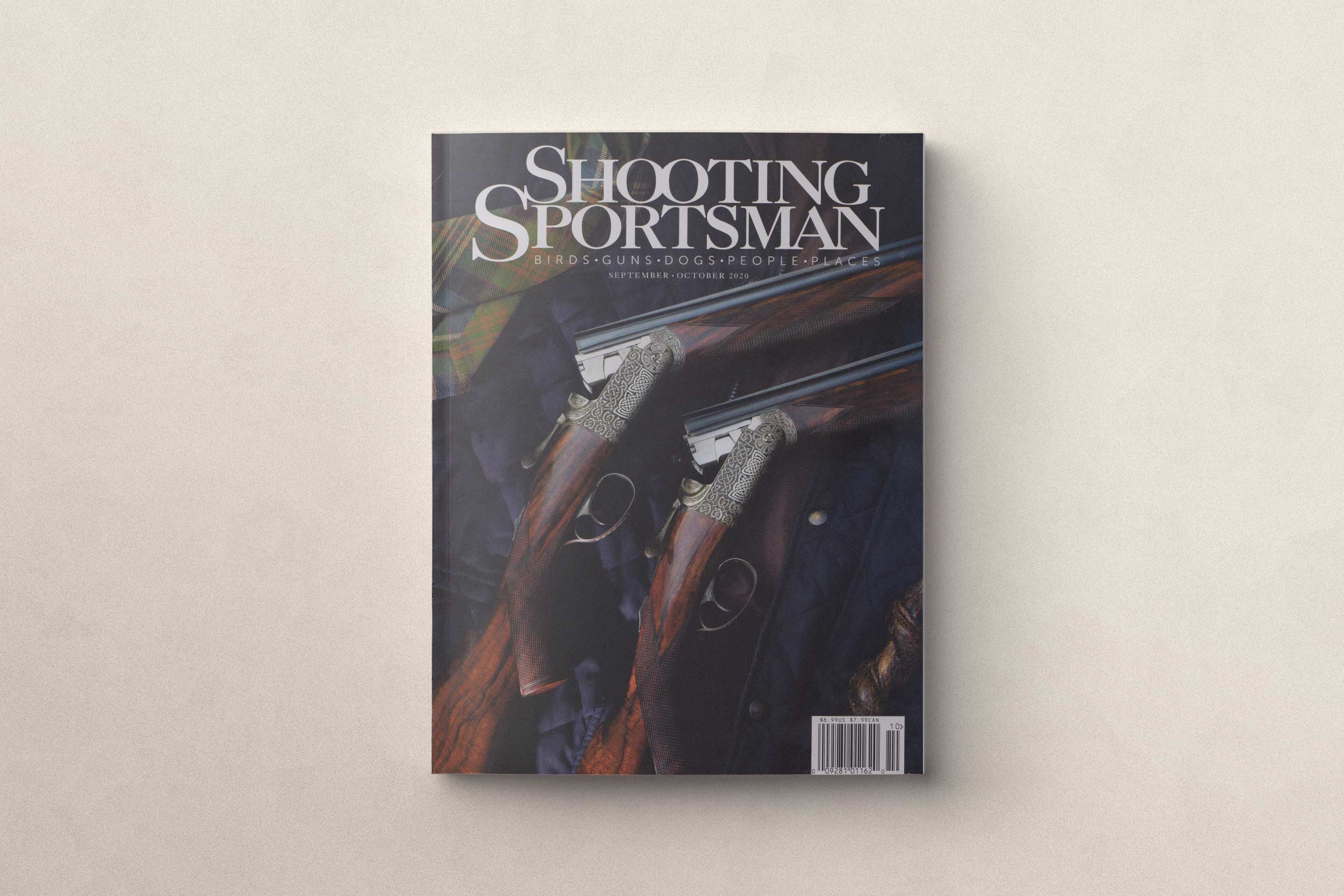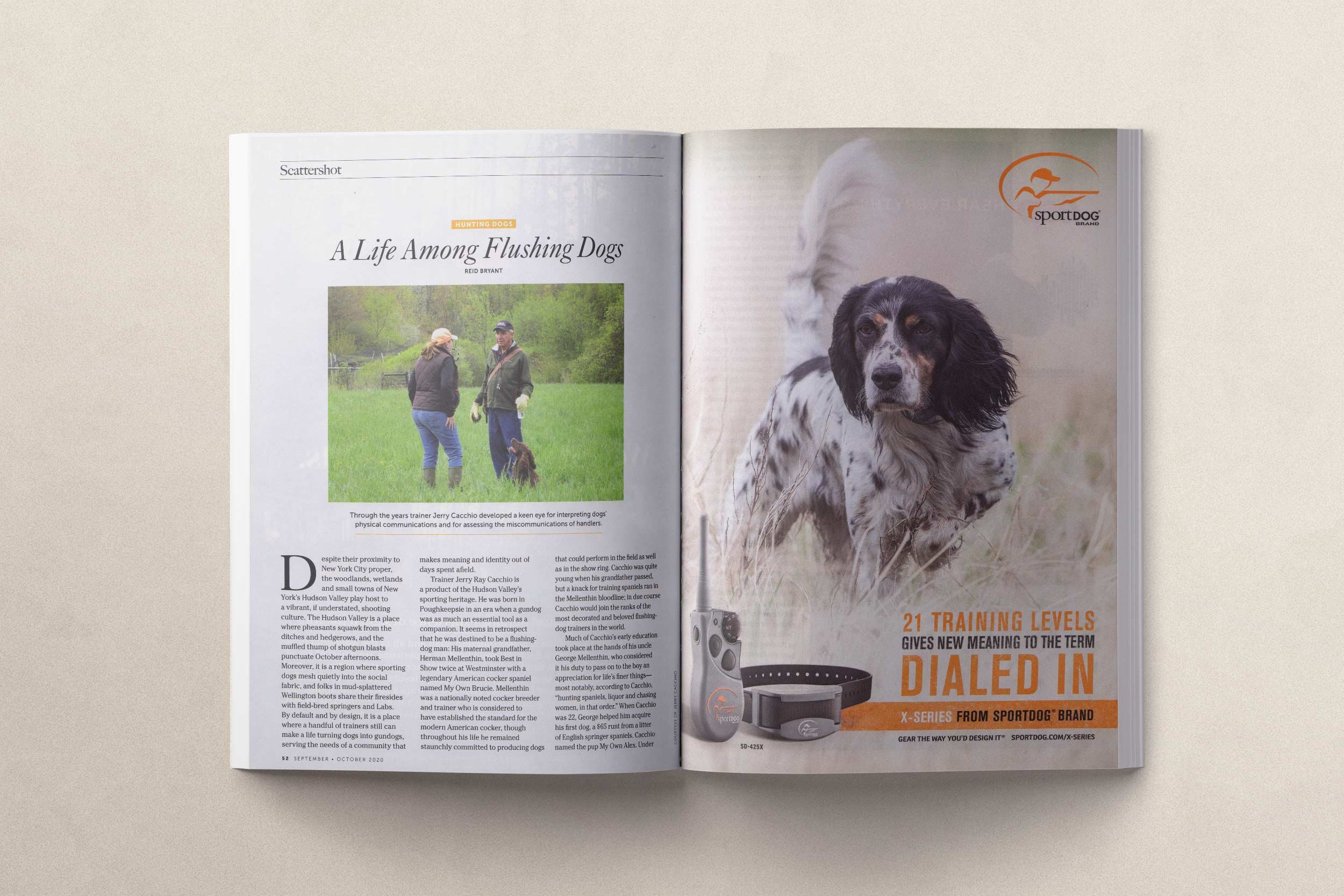A Life Among Flushing Dogs
Despite their proximity to New York City proper, the woodlands, wetlands and small towns of New York’s Hudson Valley play host to a vibrant, if understated, shooting culture. The Hudson Valley is a place where pheasants squawk from the ditches and hedgerows, and the muffled thump of shotgun blasts punctuate October afternoons. Moreover, it is a region where sporting dogs mesh quietly into the social fabric, and folks in mud-splattered Wellington boots share their firesides with field-bred springers and Labs. By default and by design, it is a place where a handful of trainers still can make a life turning dogs into gundogs, serving the needs of a community that makes meaning and identity out of days spent afield.
Trainer Jerry Ray Cacchio is a product of the Hudson Valley’s sporting heritage. He was born in Poughkeepsie in an era when a gundog was as much an essential tool as a companion. It seems in retrospect that he was destined to be a flushing-dog man: His maternal grandfather, Herman Mellenthin, took Best in Show twice at Westminster with a legendary American cocker spaniel named My Own Brucie. Mellenthin was a nationally noted cocker breeder and trainer who is considered to have established the standard for the modern American cocker, though throughout his life he remained staunchly committed to producing dogs that could perform in the field as well as in the show ring. Cacchio was quite young when his grandfather passed, but a knack for training spaniels ran in the Mellenthin bloodline; in due course Cacchio would join the ranks of the most decorated and beloved flushing-dog trainers in the world.
Much of Cacchio’s early education took place at the hands of his uncle George Mellenthin, who considered it his duty to pass on to the boy an appreciation for life’s finer things—most notably, according to Cacchio, “hunting spaniels, liquor and chasing women, in that order.” When Cacchio was 22, George helped him acquire his first dog, a $65 runt from a litter of English springer spaniels. Cacchio named the pup My Own Alex. Under George’s tough-as-nails tutelage, Cacchio trained and hunted Alex to the exacting standards set by two generations of Mellenthins. Says Cacchio of that first foray into training: “For our first two years afield, Uncle George would not even let me carry a loaded gun. He wanted all of my focus to be on working the dog, not shooting at birds.” Cacchio has remained far more interested in watching the dogs to this day.
As the years passed, Cacchio sought mentorship from many of the Hudson Valley’s storied trainers. He watched, listened and learned, but perhaps more important, he worked a tremendous number of dogs. In so doing he developed a keen eye for interpreting a dog’s physical communications and for assessing the common miscommunications of handlers.
In 1967 Cacchio stumbled headlong into professional training and thereby the pro circuit of trialing. He had been serving part-time as an assistant to Ruth Greening, one of the Hudson Valley’s favored professional flushing-dog trainers. Greening had developed the Ru-char line of springers, and when she suffered a career-ending heart attack, she asked Cacchio to take over the training and trialing of her dogs. With the coincident retirement of several local flushing-dog trainers, the young gun from Poughkeepsie became the only game in town.
Throughout Cacchio’s early career he maintained a day job at IBM, and this allowed him to invest in the construction of a kennel in Clinton Corners, New York. Pond View Kennels was to become Cacchio’s soul focus after he left IBM in 1985. With the immediate demand of the Hudson Valley’s sporting community and the need for dogs and handlers to guide at the region’s many hunt clubs, Cacchio’s training became focused on the development of gentleman gundogs: flushing dogs that would work diligently in the region’s small, cultivated-field coverts while also being well-mannered in the home. Cacchio took thorough advantage of the region’s hunt clubs not only to develop a customer network, but also to train and handle dogs in real hunting situations. A hallmark of Cacchio’s dogs and training strategy was and remains an incredible volume of live-bird exposure. Cacchio quickly became a beloved character among the prominent sportsmen who found a reprieve from the city in the pastoral communities of the Hudson Valley. Thanks to his acuity with the dogs coupled with a chatty and confident nature, he soon found himself running dogs and hunting alongside men like Jim Kinnear (Texaco), Bruno Bich (BIC Pens), Tom Brokaw, David Roderick (US Steel) and Randolph Hearst. Never one to be impressed by professional credentials, Cacchio says of these relationships, “I liked these guys because I liked their dogs, and fortunately they liked their dogs too.”
Over the course of his ownership of Pond View, Cacchio trained and trialed extensively, building a network of friends and customers in the flushing-dog world. He became fascinated with the spaniels produced in the UK and spent a good deal of time in England and Wales training, handling and working with trainers on several noted estates. He became close with Ian Openshaw, developer of the Rytex line and trainer of the Queen’s spaniels and Labs. He brought many of the UK standards to his training stateside and won two English springer spaniel open Nationals with two different dogs, one of which, NFC Pondview’s Left In The Light (“Lefty”), made it to the English Springer Spaniel Hall of Fame. He continued to train, trial, judge and guide through the early 2000s, retiring in 2005 and handing the business and much of the training philosophies to his close friend and mentee Dan Lussen. Lussen maintains Pondview II Kennels, and Cacchio continues to train alongside him each summer in Salt Point, New York. Until 2020 Cacchio was a regular judge at spaniel trials throughout the US, and he maintains the distinction of having judged more spaniel trials than anyone in the country.
A career such as Cacchio’s is heavy with accolades, but one stands out from the many. In 2012 Cacchio himself was inducted into the Field Trial Hall of Fame, and he holds this honor as a pinnacle in a career filled with long days afield, great dogs and the people who appreciate both. Though ostensibly retired, he consults extensively for Purina Sporting Dogs, and he works with The Orvis Company as the primary consultant on all facets of their gundog-associated businesses. But Cacchio claims that he is still happiest when he is back in the training fields of the Hudson Valley, where he still can help flushing dogs become the best performers they can be.
“It’s been quite a life,” Cacchio said, looking back over it. “Quite a life, indeed.”
First Published in Shooting Sportsman Magazine


